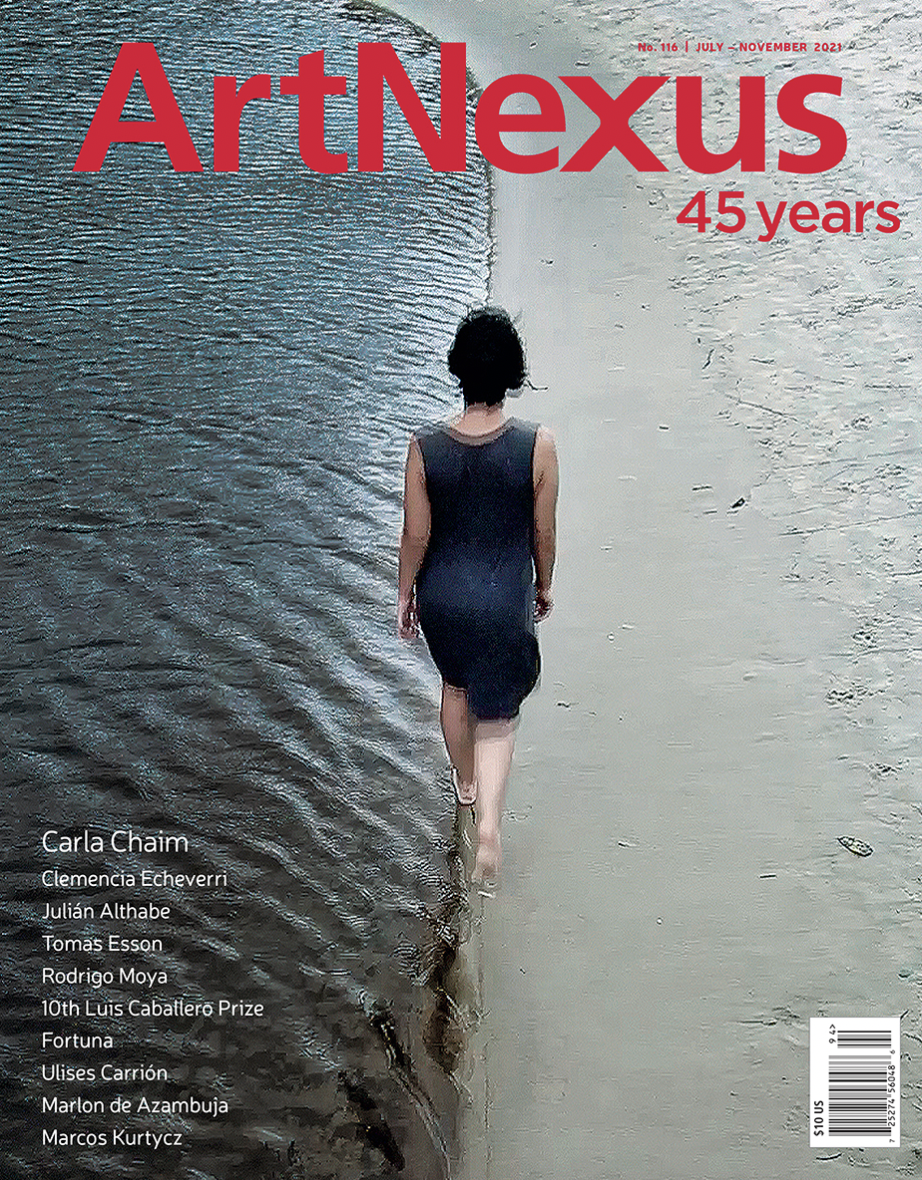

Visual Artist (1984) based in Santiago de Chile.
There is no color, only light, and shadow. Above all, gray prevails in multiple manifestations: vibrant, pixelated, metallic, brushed, opaque. We see backlit drawings, large fabric panels stretched overhead, wall- mounted metal sculptures, and abstract-looking photographs. One intuits a connection with science, outer space, and natural phenomena.
In the exhibition Position over Tension, Chilean artist Benjamin Ossa (b.1984) presents enigmas, draws with light, and invites us to explore our sense of perception. Upon entering the gallery’s white cube, we encounter two large cloth quadrangles suspended diagonally under a high ceiling. They are stretched by thin black ropes that connect them to the walls, to which
mysterious volcanic stones anchor them. They resemble sails, but also the night sky. Do they represent the wind or outer space?
The lower canvas is white with a central circle outlined in gray, and the higher one, which partially overlaps it, is black, its focal point defined by a dark circle with a white areola. The sun, a full moon?
On one of the sidewalls, several lightboxes display what the artist refers to as “light drawings.” Through layers of translucent paper, one observes dynamic compositions made up of circles and semi-circles of various sizes and shades of gray, split along their diameters, either horizontally or vertically. The first impression is that of a study in geometry that uses light to celebrate line, shadow, and shape. The space around the central motifs is covered in monochromatic pixels that activate the visual field.
Circles –both partial and complete-- also play an important part in the five brushed aluminum sculptures that seem suspended in space along the opposite wall. Each work consists of eight identically cut metal plates, placed one behind the other, with intermittent spaces. These impeccably made structures call for a closer look: to peek into the dark holes cut through the layers or to explore their structure. The series, which Ossa entitled “Denouement,” recalls the work of minimalists such as Donald Judd and his suspended metal cubes, or Robert Morris, whose repetitive geometric shapes often played perceptual tricks.
However, unlike the purely abstract values of those minimalist works, Benjamin Ossa’s sculptures relate to a natural phenomenon: the progressive stages of a solar eclipse. The successive layers of aluminum suggest the sequential moments in a time-based process. This is also the case with his “light drawings,” which the artist describes as “a reflection on the passage and build-up of a solar eclipse as an alternative for the compression of aspects related to scale, time, light, darkness, forms and space.”
Two black and white photographs at the far end of the gallery show the positive and negative versions of a single image. In the first one, a dark field contains a black circle surrounded by a ring of light, capturing the moment when the moon creates a shadow over the sun. The grainy field of the second photograph contains a light circle surrounded by a dark aura, as in a reversed eclipse. Everything falls into place: the circular cuts and patterns, the metal layers that resemble the stages in the movement of one sphere over the other, the halo around the black circumference in the suspended canvas.
In an introduction to the exhibition, Ossa explains the Position over Tension relates to the “point of tension between light and darkness” that occurs during the nominal amount of time when the moon comes between the Earth and the sun. For the artist, when the phenomenon of a solar eclipse takes place, “our biological time becomes disconnected during two minutes and thirty seconds. For an instant, a fraction of time, we become aligned with everything else.”
Through this exhibition, Ossa connects a solar eclipse to humanity, and light to shadow. In addition, beyond the exhibition, Ossa proves to be an artist who knows how to write, describe, and delve deeply into his own concepts and thought processes. Who, in addition, has carefully documented his work not only through extensive information on his website but also through the production –based on his initiative-- of publications (Early Book in 2013 and First Book in 2016) that document his oeuvre and allow others to discover what lies behind his creative process.
This is Benjamín Ossa’s first exhibition in Panama. I had already been impressed several months before by his installation entitled An Invisible Lighthouse created for the Cuban biennial of 2019 and set up in a prominent place on the Malecon, Havana’s seafront esplanade. A large cylindrical tower made of steel tubes and wire held thousands of aluminum discs that changed in both appearance and position in reaction to the sun and the wind. Just as in that imaginary lighthouse, in the works in Position over Tension, Ossa proves to be a fascinating explorer of man and natural phenomena, time and movement, and light and perception.
MÓNICA KUPFER